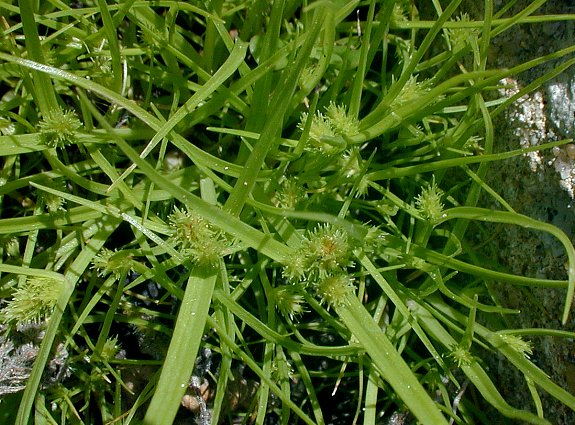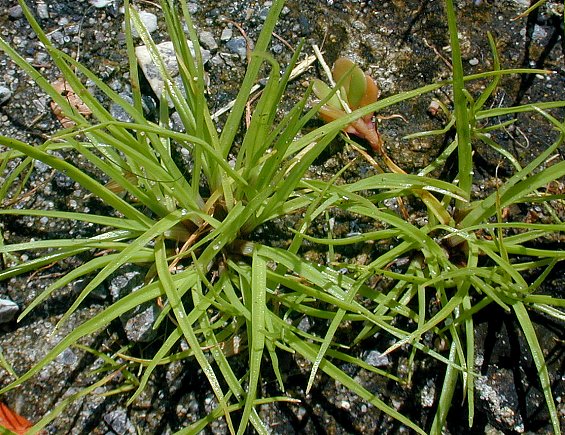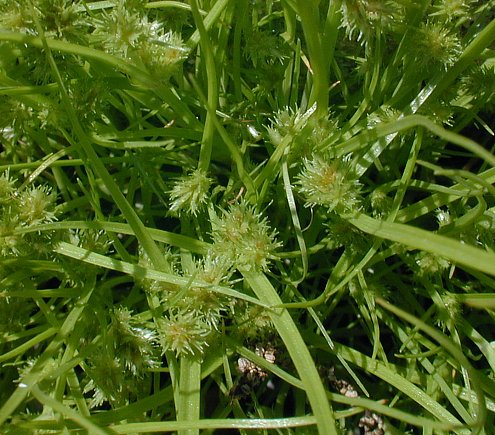Description: This flatsedge is a summer annual about 2-6" tall. It sends up several culms from the base, otherwise it is unbranched. The culms are up to 4" long, light green, hairless, and usually 3-angled. There are 0-3 alternate leaves along each culm when the flowers bloom (older leaves become brown and withered). The leaf blades are up to 3½" long and 3 mm. across; they are light green, glabrous, linear, and shallowly furrowed along their central veins. Each culm terminates in 1-3 sessile (or nearly sessile) heads of spikelets; less often, heads of spikelets may be produced on short stalks (rays) up to ½" long. Each head consists of several ascending to spreading spikelets. Each spikelet is about ¼" (6 mm.) long and flattened, consisting of 6-10 flowers and their scales in two columnar ranks.

Each flower is
enclosed in a single keeled scale; this scale is light green, hairless,
and lanceolate, tapering into a strongly recurved and conspicuous tip.
The flower is without
petals and sepals, consisting of a single stamen and a tripartite
deciduous style; the latter is barely exerted from the scale. At the
base of
the heads of spikelets, there are 2-3 leafy bracts that are up to 3½"
long and 3 mm. across; these bracts are light green, glabrous, and
linear like the
leaves. The blooming period usually occurs from mid-summer to early
fall. The flowers are cross-pollinated by the wind. As the achenes
mature, the
floral scales turn light brown; each flower produces a single achene.
Mature achenes are about 1 mm. in length, oblanceoloid-oblongoid
in shape, 3-angled, and brown. The root system consists of a
shallow tuft of fibrous roots. This sedge often forms colonies in
suitable habitats; it reproduces by reseeding itself.
Cultivation:
The preference is full or partial sun and wet to moist conditions; this
sedge grows in different kinds of soil, including those that are sandy,
thin and rocky, or mucky. This flatsedge dislikes competition from
taller plants. Because of its C4 metabolism, most growth and
development occurs during the summer, rather than the spring.

Range &
Habitat:
The native Bearded Flatsedge occurs occasionally in central and NE
Illinois, while in the southern and NW sections of the state it is less
common (see Distribution
Map). While this flatsedge is widely
distributed, its populations
tend to be scattered and local. Bearded Flatsedge also occurs in
Eurasia and South America. Habitats include low-lying areas along
rivers and ponds, prairie swales and sedge meadows, seeps, swampy
woodlands, depressions in sandstone glades, crevices of sandstone
cliffs, moist fields, and cracks along sidewalks and parking lots. This
flatsedge typically occurs in wet areas with low vegetation, although
it
adapts as well to dry rocky areas (whether natural or artificial) where
there are pockets of moisture. This flatsedge colonizes primarily
disturbed areas where there is adequate light and sparse ground
vegetation.
Faunal Associations:
Flatsedges (Cyperus spp.)
are host plants of various insects. The larvae of Diploschizia
impigritella
(Flatsedge Borer Moth) bore into the stems and leaf bases, while the
larvae of Planetella
caudata (Sedge Gall Midge) form cylindrical galls
at the bases of these sedges. Various aphids suck plant
juices, and a Blissid bug, Ischnodemus
rufipes, feeds on the foliage. The
seedheads and seeds of flatsedges are eaten to some extent
by various birds, including the Green-winged Teal, Blue-winged Teal,
Mallard, Northern Shoveler, Northern Pintail, Bobolink, Red-winged
Blackbird, and Tree Sparrow (Martin et al., 1951/1961; Havera, 1999;
Bellrose, 1942/1976). In addition to the seedheads, the Canada Goose
also eats the foliage.

Photographic
Location:
This little flatsedge was growing abundantly in the cracks between a
sidewalk and parking lot in Champaign, Illinois.
Comments:
Bearded Flatsedge (Cyperus
squarrosus) is easy to identify because its floral scales
have
strongly recurved tips. As a result, the spikelets have an odd
saw-toothed appearance along their margins. The foliage and spikelets
of young plants have a fresh spring-time appearance that is unusual for
anything that grows during the middle of summer. Other flatsedges (Cyperus
spp.) tend to be larger plants that produce
their heads of spikelets on stalks and their floral scales lack
strongly recurved
tips. The floral scales of these other species are often some shade of
yellow, red, or
brownish purple during the blooming period. In contrast, the floral
scales of
Bearded Flatsedge are light green until after the blooming period is
over, then they become light brown. Other scientific names that have
been assigned to this species in the past include Cyperus
aristatus and Cyperus inflexus.